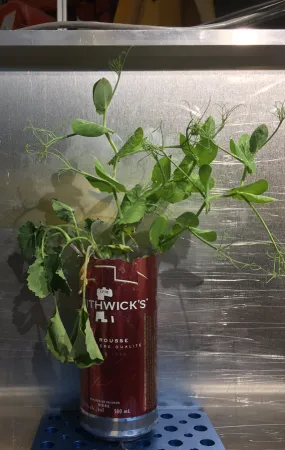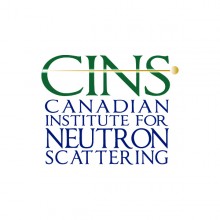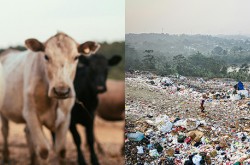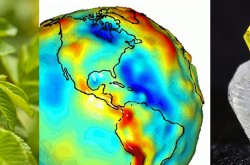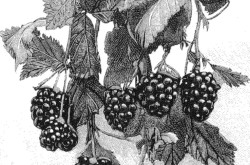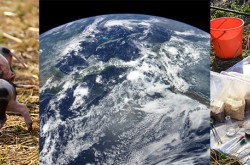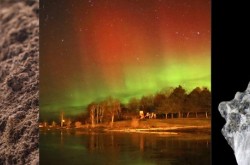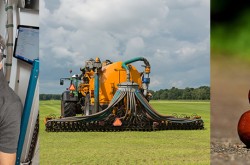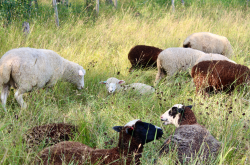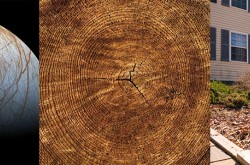Science To Solve World Hunger: Neutron Research With Plants
This article was originally written and submitted as part of a Canada 150 Project, the Innovation Storybook, to crowdsource stories of Canadian innovation with partners across Canada. The content has since been migrated to Ingenium’s Channel, a digital hub featuring curated content related to science, technology and innovation.
University of Saskatchewan scientists use neutron beams to observe plant roots in soil to aid breeding of drought-resistant crops.
Story written by Canadian Nuclear Laboratories, in cooperation with the Global Institute for Food Security and the Plant Phenotyping and Imaging Research Centre.
Two hundred years ago, the problem of the world’s population outpacing our ability to feed ourselves was identified. Thomas Malthus, in 1798, proposed that the world’s food supply would soon be insufficient to nourish the entire human race. Malthusian theory hasn’t yet proved true, since science and technology have enabled great growth in food production. Yet, he was not entirely wrong.
The United Nations predicts that the global population will reach – at minimum – nine billion people by the year 2050. New concerns, like climate change, are also affecting food supply. This isn’t a worry for the future either, as today, the Food and Agriculture Organization of the United Nations estimates that 795 million people are undernourished.
It is in the context of this big problem that two researchers hailing from Canada’s bread basket wound up beside the NRU reactor at Chalk River Laboratories with a couple pea plants in beer cans. Dr. Emil Hallin, with the University of Saskatchewan’s Global Institute of Food Security (GIFS), and Dr. Paul Arnison, a biotechnology consultant, came to Canadian Nuclear Laboratories (CNL) with the goal of demonstrating the efficacy of imaging plants with neutron beams. The time, place and people are ripe – right now – to establish neutron imaging as a minimally invasive technique that can provide unprecedented information on how plants grow, especially with respect to two key areas: root architecture and water movement.
“The science of neutron plant imaging can be thought of as a key enabler for crop breeding” says Dr. Hallin. “In the past it has been difficult to phenotype root architecture in undisturbed soil, so it has been a challenge to breed improved crop performance into that half of the plant. Visualizing roots growing in natural soil and the water and nutrient cycles they engender, is critical to creating plants and leveraging agricultural practices that enable plants to efficiently use water and nutrients found in the ground.” In fact, designing a plant with a phenotype that makes it more drought resistant, better able to acquire nutrients, and more nutritionally sound will help humanity grapple with the demands of a growing population.
Neutron imaging has the ability to give scientists a look into the sub-surface world, which is still a very mysterious place for plant breeders and biotechnologists.
“Quite simply, to make more food, we need to know more about plants,” Dr. Arnison stated, “And, what we know least about is below ground.”
Neutrons, in contrast to photons (light), easily penetrate through the soil matrix but are scattered by lighter elements such as hydrogen. In plants the most abundant molecule with hydrogen is water. Thus a neutron image shows regions of water concentration and allows visualization of the roots as they typically contain more water than the soil matrix.
Another excellent feature is that neutrons are not damaging to plants. Neutron imaging, then, is a ground-breaking (no pun intended) and minimally invasive technique that aims to rapidly visualize plant root architecture in situ (in soil).
Dr. Emil and Dr. Arnison view neutron imaging as a perfectly complementary tool to the photon imaging they have been doing at the Canadian Light Source in Saskatoon and at the high energy X-ray betatron beamline at the Advanced Laser Light Source near Montreal. With neutrons you can easily visualize water flow, and you can visualize a plant’s vessels at a cellular level. Together, x-rays and neutrons can offer access to a more complete profile of a plant’s otherwise hidden systems.
One school of thought on coping with an increased demand for food and decreasing resources to produce this food, is that agriculture must challenge itself to do more with less. Learning more about root architecture, the complex underground network that allows a plant’s nutrient and water uptake, will help the next generation of plant breeders to develop plants with phenotypes that allow for better use of a limited amount of fertilizer and water.
Presently, a problem is that a good deal of applied fertilizer is wasted as run off into groundwater. So, looking at plants that are more efficient at acquiring nutrients could lead to the development of crops that need less fertilizer, and to which fertilizer could be provided in a more targeted fashion. Likewise, studying water dynamics means that plants could be developed to optimize their water efficiency.
There is a caveat with neutron imaging of plants. If imaging is to give clear pictures that will be useful, the neutron source must be powerful enough to do imaging quickly – and not every neutron beamline has sufficient power. The Canadian Neutron Beam Centre (CNBC) found in NRU has six powerful beamlines, and can provide images in a rapid enough manner to be useful. Whereas, at other places with a neutron source, the images may be processed too slowly and the plant, since it is living, will change in the course of an image acquisition making the imaging essentially useless. CNL also has one-of-a-kind facilities that allow for research with deuterium, which used in combination with neutron imaging, to show water dynamics in a plant. Deuterium, when introduced, will displace regular water, and it will appear lighter, thus providing researchers with images that trace how water is moving throughout a plant.
“Exploding,” is the word Dr. Arnison used to describe the use of plant imaging in the last few years. Genomics has come to the point where it is sophisticated enough that imaging can be vital. According to Paul, the international biotechnology multinationals are already heavily investing in a variety of imaging technologies and the science is advancing rapidly. He sees it as a matter of time before industries beyond biotechnology, like forestry, look to plant imaging for answers.
While Australia and Europe are at the cutting edge of plant imaging, neutron imaging has only been done on plants in Canada and the United States. As the world’s fifth largest agricultural exporter, it seems there is an opportunity for Canada to carve its niche in the growing field of plant imaging, with research like Emil and Paul’s cutting a trail for neutron imaging, specifically.
Much like neutron imaging complements other plant imaging techniques, Emil’s background in nuclear physics, complements Paul’s background in plant biochemistry, for this area of research. Between the pair there is a wealth of experience working in nuclear science and biotechnology.
Dr. Hallin, first visited NRU one year ago, after obtaining a grant as a part of the creation of the Plant Phenotyping and Imaging Research Centre (P2IRC), which is managed by GIFS at the University of Saskatchewan. P2IRC is a part of the, “Designing Crops for Global Food Security” research program run by GIFS.
The grant was from the Canada First Research Excellence Fund (CFREF), which awarded just five grants in 2015 – the inaugural year of the grant competition. The $37.2 million over seven years aims to support research that will, in the words of GIFS, “transform crop breeding and provide innovative solutions to national and global food security.”
There are many advantages to maintaining and growing Canada’s research abilities, but, developing domestic plant imaging capabilities is an area where Canada could particularly excel, due to existing resources, and enhance the scientific community’s knowledge in an area that would benefit some of our biggest industries, such as agriculture and forestry. Furthermore, since restrictions on importing and exporting plants prevent easy transfer of vegetation across borders, doing plant imaging research in European or American laboratories would not increase Canada-specific knowledge in this area.
Future areas where root imaging may be important are in the study of root diseases and predation. Many seeds that are planted fail to germinate and survive. They may be attacked by a fungus or eaten by an insect larva. Neutron imaging offers a way to observe disease and predators in the soil without disturbing the growing conditions to make the observations.
Many crops, especially those that can fix atmospheric nitrogen, have complex symbiotic relationships with plant roots. The ability of certain microbes to colonize roots and assist in nutrient absorption and nitrogen fixation could be monitored remotely by neutron imaging.
Clearly, there are many remaining mysteries that plant imaging has the capacity to unlock. And, with international researchers racing ahead, plant imaging is an ever expanding tool in the noble goal of achieving greater global food security.
And, the mystery of the empty beer can? Aluminum is transparent to neutrons; repurposed beer cans were a simple solution.




